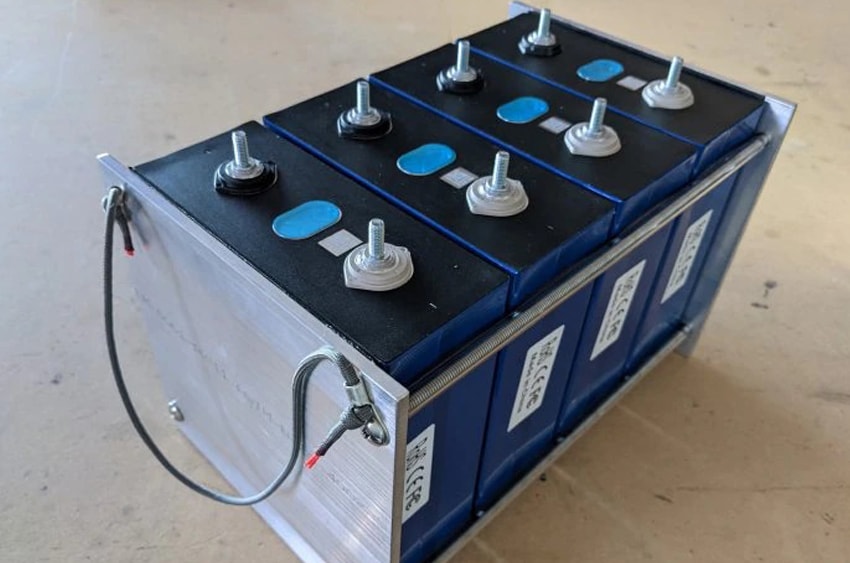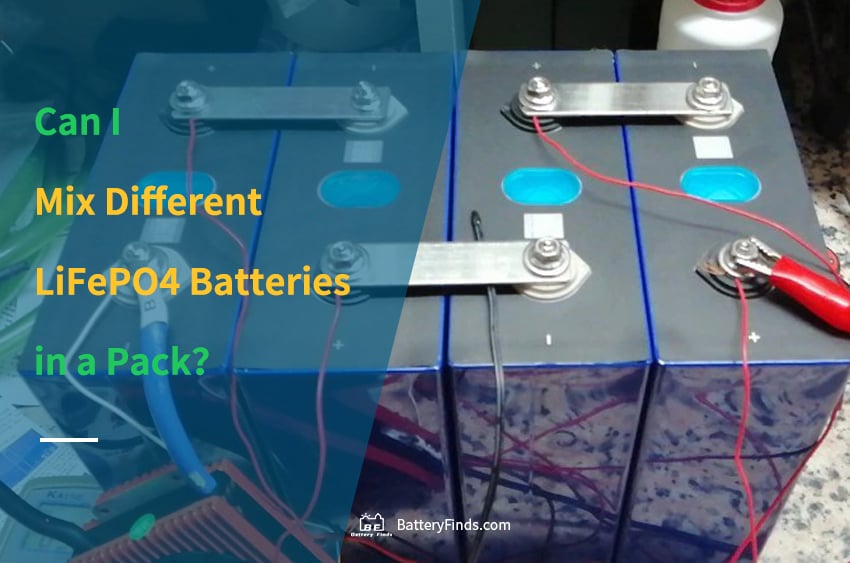Can I Mix Different LiFePO4 Batteries? Well, to mix different LiFePO4 batteries is not recommended. The reason is very simple, mixing different LiFePO4 batteries will affect the effect of the entire battery pack, including output power, safety, etc. But for some specific details, I hope this Blog can help you learn relevant knowledge.
Mixing different LiFePO4 batteries, we usually say “not recommended”, why is it not recommended? We can keep this question first. Generally speaking, the use of LiFePO4 batteries can be divided into two categories, discharging and charging.
About mixing different LiFePO4 batteries

*The LiFePO4 battery pack as shown in the picture has been in rigth connected.
Discharge is the part that more people pay attention to. Because the performance of a normal battery pack depends on the size, type, voltage, capacity, brand, and newness of each battery. If these parameters are not the same, it will cause confusion in the function of the entire battery pack, causing problems such as degradation of battery pack performance.Some rare cases even leakage and explosion. Of course, LiFePO4 battery will not explode, because it depends on its chemical properties.
Different shapes of LiFePO4 batteries mean some differences. Common LiFePO4 batteries are cylindrical, prismatic, etc. If you mix these batteries, I believe your electrical appliances will soon be damaged, because the different manufacturing methods will bring some characteristics. The slight difference.
Currently popular rechargeable batteries are generally nickel-metal hydride batteries, lead-acid batteries and lithium-ion batteries. However, these batteries are very different, which can be specifically expressed in terms of capacity, voltage, cycle times, life, safety, DOD, and so on. It is definitely not a good idea to mix these batteries. Different types of batteries in the same battery pack will have a great safety hazard. The same type of battery may only affect the battery performance, but if the two are completely different Terrible things will happen to batteries (such as AGM batteries and LiFePO4 batteries). Due to the difference in voltage and DOD, LiFePO4 batteries will undoubtedly be killed, so do not mix AGM batteries with LiFePO4 batteries!
LiFePO4 batteries of different capacities are better understood. A smaller capacity will definitely discharge faster than a larger capacity battery. However, in the case of parallel connection, batteries with similar capacities can be mixed.
In addition, there will also be differences between brands. Frequently, batteries of the same type, voltage and capacity produced by different brands will have subtle differences, because at present, many battery brands produce batteries that are better than the nominal ones. The capacity is 5%~10% higher, which causes the differentiation of batteries between brands. Therefore, do not mix LiFePO4 batteries of different brands.
Finally, how old or new each cell is will also affect the overall performance of the battery pack to a greater or lesser extent. If possible, it is best not to mix old and new batteries. After the old battery is used for many times, the parameters may change to some extent. Likewise, old batteries can affect the performance of new batteries, which in turn affects the performance of the entire battery pack. In principle, it is allowed to mix old and new batteries, but for the overall performance of the battery pack, it will be better to use the same new batteries.
The charging part of LiFePO4 battery is more subtle. Similarly, batteries of different shapes, types, brands, old and new levels cannot be mixed. However, under the condition that all parameters are the same, LiFePO4 batteries of different capacities can be charged in parallel. For a simple example, two water tanks with the same height but different widths are connected together by a connector, and they are filled with water at the same time. Eventually, they will be filled with water at the same time without causing any harm. Similarly, the battery is the same. When only the capacity is different, it is finally fully charged at the same time, which will not cause any damage to the LiFePO4 battery.
Disadvantages of mixing different LiFePO4 batteries

*The LiFePO4 battery pack as shown in the picture has not been connected.
First of all, if you mix different LiFePO4 batteries, one of the most obvious consequences is that the effect of your battery pack will not meet your expectations. In the battery pack, high-performance batteries will always be constrained by weaker batteries. For example, when discharging, the voltage is forced to drop to the same level as the weaker battery, which increases the risk of battery damage. In the process of using such a battery pack, the performance difference of each battery will become larger and larger, such as capacity, discharge rate, etc. These differences will cause the BMS to lose its function and fail to provide you with safety protection. Finally, one or more of the batteries will be over-discharged, causing damage or leakage, causing irreparable losses. And due to a problem with the battery pack, the output power is of course unstable, and your electrical appliances may suffer some damages and cause malfunctions.
Summary
Through the above description, I believe you already know why we keep saying “not recommended” to mix different LiFePO4 batteries. Our suggestion is to use LiFePO4 batteries of the same shape, same type, same brand, same capacity, same voltage, same new and old level to build a battery pack, and don’t forget to also choose the appropriate busbars to connect your battery. Learn more here. Correctly selecting and connecting the battery not only can provide unimaginable performance, but the most important thing is also very safe.


noone talks about ampere. can they be mixed together like 5A cell with 10A cell or with high drain cell like 25A.
When mixing different LiFePO4 batteries in a pack, it is generally recommended to use cells with the same specifications, including capacity, voltage, and maximum discharge current. While it is possible to mix cells with different ampere ratings, this can lead to imbalances in the pack, with some cells discharging more quickly than others.
In general, we recommend avoiding mixing cells with widely different ampere ratings. For example, it may be possible to mix a 5A cell with a 10A cell, but mixing a 5A cell with a high-drain cell rated for 25A is not recommended. This could lead to over-discharging of the lower-rated cell, which can cause it to become damaged or even fail.
For the best performance and safety, it is recommended to use cells with identical specifications in a pack. If you do need to mix cells with different specifications, it is important to take extra precautions to ensure that the cells are balanced and that the pack is managed carefully to prevent over-discharging or overcharging of any individual cell.
I have a RV van we are fixing up with a 100AH LifeP04 battery charged by 3 methods: 1. 350 watts of solar collectors through a solar charger 2. Using the van alternator through a Renogy 40 amp DC to DC charger 3. Using a 20 amp LifePO4 battery charger when hooked up to a utility provided campsite. There is a 2000 pure sine wave inverter for those times we want to run a microwave or other 120V appliance.
My question is about charging different capacity batteries in parallel that this article addresses. On occasion we may bring our electric powered canoe with a 30lb thrust motor. This setup is actually a converted canoe with outriggers to make a Philippine “Bangka Boat” . The shade system is partly solar collectors to power the motor and charge the 50AH LifeP04 battery made by the same manufacturer. I bought the 50 amp for its size and weight. Turns out the 100AH version was quite light in weight compared to a GEL type. If I had to do it all over again, I would have bought 2 100AH and running in parallel may not be an issue, but maybe because one would be fully charged while the boat one discharged. Can I charge both batteries in parallel to get the 50amp a full charge between boating outings if needed? This will be a charging situation only and not have the 50AH act as a battery to power the van. Mostly charging it while I’m driving or by the solar on a sunny day, since 350 watts is pretty good power. I could hook up a relay to disconnect it with a switch in the van or I could use relays and totally isolate the batteries from each other and the chargers.
Any advice would be appreciated.
Marshall
Hi Marshall,
Thanks for reaching out with your question about charging two different-capacity batteries in parallel.
In general, it’s not recommended to charge batteries of different capacities in parallel, as the larger battery may not be fully charged while the smaller one is already at capacity. This can lead to imbalances in the charging process and potential damage to the batteries.
However, since you will only be charging the 50AH battery as a standalone charging situation and not using it as a power source for the van, it may be possible to charge both batteries in parallel if you take certain precautions.
One option would be to use relays to isolate the batteries from each other and from the chargers so that each battery is charged separately. You could also consider using a battery isolator or a charge controller with dual battery inputs to manage the charging process.
Another option would be to use a battery management system (BMS) that can balance the charging process and ensure that both batteries are charged to their full capacity without damaging them.
Ultimately, the best approach will depend on the specific details of your setup and the charging methods you are using. I would recommend consulting with a qualified electrician or battery expert to determine the safest and most effective way to charge your batteries in parallel.